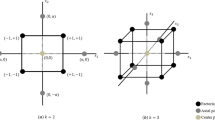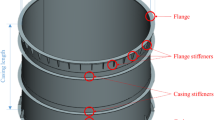Abstract
This paper proposes a new multiobjective optimization with elliptical constraints approach for nonlinear models implemented in a cladding process of ABNT 1020 carbon steel plate using austenitic ABNT 316L stainless steel cored wire. Stainless steel stands out among the cladding materials as it allows obtaining surfaces with determined desirable characteristics from lower cost materials. This kind of process may be controlled by a relatively small number of input variables, i.e., the wire feed rate (WF), voltage (V), welding speed (WS), and the distance from the contact tip to the workpiece (N). Besides that, many outputs can be evaluated and simultaneously optimized. In the present paper, dilution (D), yield (Y), convexity index (CI), and penetration index (PI) were investigated. In order to consider the problem’s multivariate nature, techniques such as factor analysis and Bonferroni’s multivariate intervals were applied combined with elliptical constraints. The response variables were mathematically modeled using Poisson regression, and the obtained results were satisfactory since accurate models were achieved. The normal boundary intersection (NBI) method produced a set of viable configurations for the input variables that allows the experimenter to encounter the best system setup regarding the importance level of each response. Feasible and non-dominated solutions were found which means that the best possible scenario considering all the constraints was reached.









Similar content being viewed by others
Data availability
All the data used in this research were extracted from [22].
References
Pessoa ARP (2010) Seleção de parâmetros através do método Taguchi para soldagem de revestimento com ligas de níquel pelo processo MIG/MAG. Soldag. insp. (Impr.), São Paulo. 15(4): 317–324
Murugan N, Parmar RS (1997) Stainless steel cladding deposited by automatic gas metal arc welding. Weld J 76:391s–403s
Gupta D, Sharma A (2011) Development and microstructural characterization of microwave cladding on austenitic stainless steel. Surf Claddings Technol, Elsevier 205(21–22):5147–5155
Phillips AL (1965b) Welding handbook: special welding processes and cutting, vol 3. American Welding Society, London, p 4
Marques PV, Modenesi PJ, Bracarense AQ (2005) Soldagem: fundamentos e tecnologia. Belo Horizonte, UFMG, p 362
Murugan N, Parmar RS (1994) Effects of MIG process parameters on the geometry of the bead in the automatic surfacing of stainless steel. J Mater Process Technol 41(4):381–398
Zhang P, Liu Z (2017) On sustainable manufacturing of Cr-Ni alloy claddings by laser cladding and high-efficiency turning process chain and consequent corrosion resistance. J Clean Prod, Elsevier 161:676–687
Flandinet L, Tedjar F, Ghetta V, Fouletier J (2012) Metals recovering from waste printed circuit boards (WPCBs) using molten salts. J Hazard Mater 213–214:485–490
Peng S, Li T, Li M, Guo Y, Shi J, Tan GZ, Zhang H (2019) An integrated decision model of restoring technologies selection for engine remanufacturing practice. J Clean Prod, Elsevier 206:598–610
Palani PK, Murugan N (2006) Development of mathematical models for prediction of weld bead geometry in cladding by flux cored arc welding. Int J Adv Manuf Technol 30(7–8):669–676
Palani PK, Murugan N (2007) Optimization of weld bead geometry for stainless steel claddings deposited by FCAW. J Mater Process Technol 190(1–3):291–299
Kannan T, Murugan N (2006) Effect of flux cored arc welding process parameters on duplex stainless steel clad quality. J Mater Process Technol 176(1–3):230–239
Dupont JN, Marder AR (1996) Dilution in single pass arc welds. Metall Mater Trans B 27(3):481–489
Banovic SW, Dupont JN, Marder AR (2002) Dilution and microsegregation in dissimilar metal welds between super austenitic stainless steel and nickel base alloys. Sci Technol Weld Join 7(6):374–383. https://doi.org/10.1179/136217102225006804
Gittos MF, Gooch TG (1996) Effect of iron dilution on corrosion resistance of Ni-Cr-Mo alloy cladding. Br Corros J UK 31(4):309–314. https://doi.org/10.1179/bcj.1996.31.4.309
Shahi AS, Pandey S (2006) Prediction of dilution in GMA and UGMA stainless steel single layer cladding using response surface methodology. Sci Technol Weld Join 11(6):634–640
Balasubramanian V, Lakshminarayanan AK, Varahamoorthy R, Babu S (2009) Application of response surface methodology to prediction of dilution in plasma transferred arc hardfacing of stainless steel on carbon steel. Int J Iron Steel Res 16(1):44–53
Shahi AS, Pandey S (2008) Modelling of the effects of welding conditions on dilution of stainless steel claddings produced by gas metal arc welding procedures. J Mater Process Technol 196(1–3):339–344
Black JT, Hunter SL (2003) Lean manufacturing and cell design. Society of Manufacturing Engineers, Chicago
Piercy N, Rich N (2009) Lean transformation in the pure service environment: the case of the call service centre. Int J Oper Prod Manag 29(1):54–76
de Almeida FA, Santos ACO, de Paiva AP, Gomes GF, Gomes JHF (2020) Multivariate Taguchi loss function optimization based on principal components analysis and normal boundary intersection. Eng Comput, Springer. https://doi.org/10.1007/s00366-020-01122-8
Gomes JHF, Paiva AP, Costa SC, Balestrassi PP, Paiva EJ (2013) Weighted multivariate mean square error for processes optimization: a case study on flux-cored arc welding for stainless steel claddings. Eur J Oper Res, Elsevier 226:522–535
de Freitas GJH et al (2011). Otimização de múltiplos objetivos na soldagem de revestimento de chapas de aço carbono ABNT 1020 utilizando arame tubular inoxidável austenítico. Soldag. insp. (Impr.), São Paulo 16(3):232–342
Jeffus L (2004) Welding: principles and applications, 5th edn. Delmar Learning, Australia, p 904
Rodrigues LO, Paiva AP, Costa SC (2008) Otimização do processo de soldagem com eletrodo tubular através da análise da geometria do cordão de solda. Soldagem & Inspeção 13(2):118–127
Paiva EJ, Rodrigues LO, Costa SC, Paiva AP, Balestrassi PP (2010) Otimização do processo de soldagem FCAW usando o Erro Quadrático Médio Multivariado. Soldag insp 15(1):31–40
Bryman A (1989) Research methods and organization studies (contemporary social research), 1st edn. Routledge, London
Valdenebro, Meseguer JL, Portolés A, Conesa E (2018) Electrical parameters optimisation on welding geometry in the 6063-T alloy using the Taguchi methods. Int J Adv Manuf Technol 98:2449–2460
Braguine TB, DE Alcântara DS, Castro CAC, DOS Santos GHR (2018) Influence of welding parameters on aluminum tubes AA6063 by the CDFW process | [Influência dos parâmetros de soldagem em tubos de alumínio AA6063 pelo processo CDFW]. Soldag insp 23(1):3–16
Valdenebro, Meseguer JL, Portolés E Oñoro J (2016) Numerical study of TTP curves upon welding of 6063-T5 aluminium alloy and optimization of welding process parameters by Taguchi’s method. Indian J Eng Mater Sci 23:341–348
Costa DMD, Brito TG, Paiva AP, Leme RC, Balestrassi PP (2016) A normal boundary intersection with multivariate mean square error approach for dry end milling process optimization of the AISI 1045 steel. J Clean Prod 135:1658–1672
Montgomery DC (2013) Design and analysis of experiments, 8th. edn [S.l.]. John Wiley & Sons, Inc, Hoboken
Singh D, Rao PV (2007) A surface roughness prediction model for hard turning process. Int J Adv Manuf Technol, Springer 32:1115–1124
Myers RH, Montgomery D (2002) Response surface methodology: process and product optimization using designed experiments, 2nd edn. [S.l.]. John Wiley & Sons, Inc, Hoboken
Torres AF, Rocha FB, Almeida FA, Gomes JHF, Paiva AP, Balestrassi PP (2020) Multivariate stochastic optimization approach applied in a flux-cored arc welding process. IEEE Access 8:61267–61276
Lu Y, Xu Z (2017) Recycling non-leaching gold from gold-plated memory cards: parameters optimization, experimental verification, and mechanism analysis. J Clean Prod, Elsevier 162:1518–1526
Nasiri R, Arsalani N (2018) Synthesis and application of 3D graphene nanocomposite for the removal of cationic dyes from aqueous solutions: response surface methodology design. J Clean Prod, Elsevier 190:63–71
Almeida FA, Gomes GF, Paula VR, Corrêa JE, Paiva AP, Gomes JHF, Turrioni JB et al (2018) A weighted mean square error approach to the robust optimization of the surface roughness in an AISI 12L14 free-machining steel-turning process. J Mech Eng, Strojniški vestnik 64(3):147–156
Myers RH, Montgomery DC, Anderson-Cook CM (2009) Response surface methodology: process and product optimization using designed experiments, 3rd edn. Wiley, New York
Gaudêncio JHD, Almeida FA, Turrioni JB, Quinino RC, Balestrassi PP, Paiva AP (2019) A multiobjective optimization model for machining quality in the AISI 12L14 steel turning process using fuzzy multivariate mean square error. Precis Eng, Elsevier 56:303–320
Belinato G, Almeida FA, Paiva AP, Gomes JHF, Balestrassi PP, Rosa PARC (2019) A multivariate normal boundary intersection PCA-based approach to reduce dimensionality in optimization problems for LBM process. Eng Comput, Springer 35:1533–1544
Das I, Dennis JE (1998) Normal-boundary intersection: a new method for generating the Pareto surface in nonlinear multicriteria optimization problems. SIAM J Optim 8:631–657
Oujebbour F, Habbal A, Ellaia R (2013) Optimization of concurrent criteria in the stamping process. In: Proceedings of 2013 International Conference on Industrial Engineering and Systems Management (IESM), Rabat, pp 1–10
Moura D, Barcelos V, Samanamud GRL, França AB, Lofrano R, Loures CCA, Naves LLR, Amaral MS, Naves FL (2018) Normal boundary intersection applied as multivariate and multiobjective optimization in the treatment of amoxicillin synthetic solution. Environ Monit Assess 190(3):140
Naves FL, de Paula TI, Balestrassi PP, Braga WLM, Sawhney RS, de Paiva AP (2017) Multivariate normal boundary intersection based on rotated factor scores: a multiobjective optimization method for methyl orange treatment. J Clean Prod Elsevier 143:413–439
Myers RH, Montgomery DC, Vining GG, Robinson TJ (2010) Generalized linear models with applications in engineering and the sciences
Johnson RA, Wichern DW (2007) Applied multivariate statistical analysis, 6th edn. Prentice Hall, Upper Saddle River
Hair JF, Black WC, Babin BJ, Anderson RE, Tatham RL (2006) Multivariate data analysis 6th Edition. Pearson Prentice Hall, Upper Saddle River
King G How not to lie with statistics [Online] Available in < https://gking.harvard.edu/files/mist.pdf>: Access in: [August 23, 2020]
Paiva AP, Paiva EJ, Ferreira JR, Balestrassi PP, Costa SC (2009) A multivariate mean square error optimization of AISI 52100 hardened steel turning. Int J Adv Manuf Technol 43:631–643
Acknowledgments
The authors would like to thank the Brazilian agencies of CAPES, CNPq, and FAPEMIG for supporting this research.
Author information
Authors and Affiliations
Contributions
JHG, APP, and PPB: resources; JHG, APP, ERL, SCS, ELR, and PPB: investigation; ERL, ELR, and SCS: data curation; SCS, ELR, and ERL: writing—original draft preparation; ELR, SCS, and ERL: writing—review and editing; JHG, APP, ERL, SCS, ELR, and PPB: visualization; APP, PPB, and JHG: supervision. All of the authors have read and agreed to publish this version of the manuscript.
Corresponding author
Ethics declarations
Conflict of interest
The authors declare that they have no conflict of interest.
Ethical approval
Not applicable.
Consent to participate
Not applicable.
Consent for publication
Not applicable.
Additional information
Publisher’s note
Springer Nature remains neutral with regard to jurisdictional claims in published maps and institutional affiliations.
Rights and permissions
About this article
Cite this article
Luz, E.R., Romão, E.L., Streitenberger, S.C. et al. A new multiobjective optimization with elliptical constraints approach for nonlinear models implemented in a stainless steel cladding process. Int J Adv Manuf Technol 113, 1469–1484 (2021). https://doi.org/10.1007/s00170-020-06581-3
Received:
Accepted:
Published:
Issue Date:
DOI: https://doi.org/10.1007/s00170-020-06581-3




